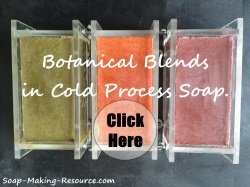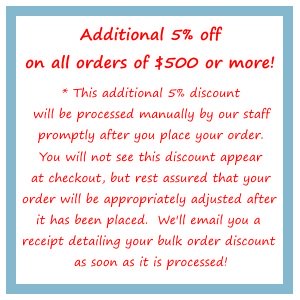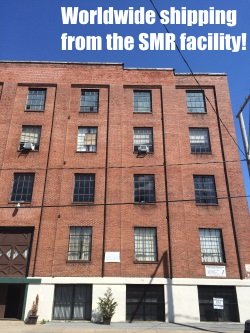Shampoo Bar Recipe
The following tutorial demonstrates my own shampoo bar recipe. In this batch, we will be using a great hair-care essential oil blend that incorporates our therapeutic grade rosemary essential oil and tea tree essential oil as well as our invigorating pink grapefruit essential oil.
We will also be using some unique additives including tussah silk and raw eggs! Furthermore, this recipe has a large portion of castor oil which produces an awesome lather.
Are you ready to start using a paraben free and SLS/SLES free shampoo? Follow along with my shampoo bar recipe below and create your own batch today!
This soap recipe will produce 5 pounds of soap and will fit perfectly in our 5 pound acrylic soap mold or 5 pound wooden soap mold.
Here is a picture of our finished product produced by my shampoo bar recipe:
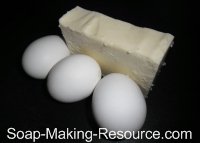
Get the Kit! (Out of Stock)
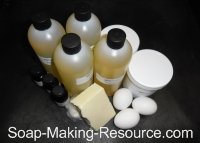
Get the shampoo bar recipe kit today and make all natural shampoo right in your kitchen! The kit will include 32 ounces of olive oil, 13.5 ounces of palm oil (RBD), 16 ounces of castor oil, 16 ounces of avocado oil, 13.5 ounces of shea butter, 1 ounce of tea tree essential oil, 1 ounce of rosemary essential oil, 1 ounce of grapefruit essential oil and a small portion of silk. This kit will supply you with more than enough of the above ingredients to make the 5 pound batch of shampoo bar soap as explained in the below tutorial. To complete the recipe, you will need to supply the 3 eggs, distilled water and sodium hydroxide.
I also encourage you to pick up the 5 pound acrylic soap mold or 5 pound wooden soap mold from soap-making-resource.com. Our 5 pound molds will fit this batch perfectly!
Each kit will also include full written instructions for completing the shampoo bar recipe and contact information for my own personal lye source.
Shampoo Bar Recipe Kit: $65.94 Out of Stock
This shampoo bar recipe kit does not include lye, eggs or distilled water. Lye can be purchased at many local hardware stores and we will also provide within your soap kit contact information for my personal lye source. This alone is a great value! Eggs and distilled water, obviously, can be picked up at your local grocery store.
* All ingredients within this recipe are also available to purchase in bulk right here at soap-making-resource.com.
Here is the exact recipe formula that we will be using for this batch:
- Olive Oil = 26.5 Ounces (50% of total oils)
- Palm Oil (RBD) = 10.6 Ounces (20% of total oils)
- Castor Oil = 7.95 Ounces (15% of total oils)
- Avocado Oil = 5.3 Ounces (10% of total oils)
- Shea Butter, Ghana = 2.65 Ounces (5% of total oils)
- Tea Tree Essential Oil = 21 grams (.75 Ounces)
- Rosemary, Camphor Essential Oil = 28 grams (1 Ounce)
- Grapefruit, Pink Essential Oil = 21 grams (.75 Ounce)
- Tussah Silk = 1/2 gram (about the size of half a cotton ball)
- Egg Yolks = 3 medium egg yolks
- Distilled Water = 20 ounces
- lye = 6.8 ounces (192 grams)
*This recipe has a 5% super-fat.
*All measurements are weight measurements, not liquid measurements.
Below is the step by step tutorial for making my shampoo bar soap:
Step 1) First we need to create our lye solution. Measure out 192 grams of dry sodium hydroxide in a chemical safe container.
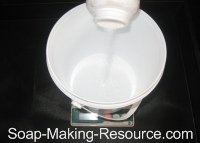
Next, measure out your distilled water in a separate heat and chemical safe bucket. For this recipe, you need to weigh out 20 ounces of water for your batch. Keep in mind that these are weight ounces, not liquid ounces.
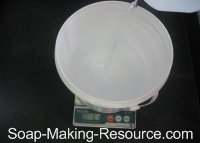
At this point, we will already be adding our first additive, which is silk! Place a small pinch of silk, about the size of half a cotton ball, into your measured out water. Silk will add, for lack of a better word, a silky feeling to your soap and it will also increase the products lather.
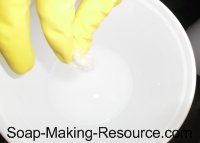
Now that your lye and water portions are accurately measured out and your silk has been added to the water, pour the lye into your water to create your lye solution.
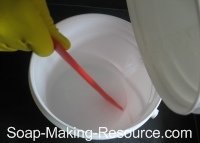
Don't forget... When you create your lye solution, you should do so in a well ventilated area. As you pour the lye into your water, a strong fume will be present which you don't want to breathe in. Also, be aware that your solution will heat up substantially once it is created.
During the first few minutes, you will notice that the silk, which is actually a protein, will dissolve into the lye solution. You may need to carefully stir your lye solution in order to help the silk fully dissolve.
Now that your solution is successfully made, set a candy thermometer into the lye water and place it off to the side to cool. We will use this lye solution very soon in a later step.
Step 2) Next, let's measure out our soap making oils needed for this shampoo bar recipe. In your stainless steel pot, weigh out all your oils according to the shampoo bar soap recipe above. Be sure to measure accurately!
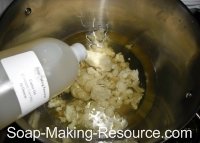
Now that all your oils are successfully measured, you can melt them all to a liquid form. Be sure to melt your oils using only a low setting on your cook-top. You don't want to accidentally burn your soap making oils!
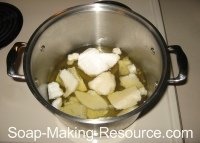
Step 3) While we wait for our oils to thoroughly melt, we are going to prepare our additives. In this batch, we will be adding our own hair-care essential oil blend, tussah silk fiber and raw egg yolks. Keep in mind that we have already taken care of adding the tussah silk to our batch as it was dissolved earlier in the lye solution; so we only need to prepare our essential oil blend and our eggs.
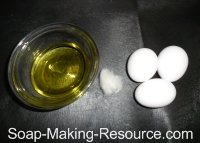
That's right, we will be adding fresh egg yolks to this batch which will give your finished product an extra super-fat level, unique texture and the skin care benefits of vitamin A, D and E! I think you will love using egg yolks in your soap and below I will explain exactly how to incorporate them! Egg yolks are the perfect addition for a shampoo bar recipe.
First, let's create our essential oil blend. This blend will be made up of Soap Making Resource's therapeutic grade rosemary, camphor essential oil, our therapeutic grade tea tree essential oil and our therapeutic grade pink grapefruit essential oil. Rosemary and tea tree are both known for their skin and hair care benefits and grapefruit essential oil gives this blend a lovely top note that is perfectly invigorating for a warm early morning shower.
Measure out exactly 28 grams of rosemary, camphor essential oil, 21 grams of tea tree essential oil and 21 grams of grapefruit essential oil to create the blend.
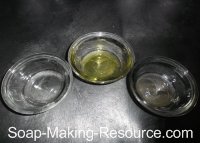
Why are we measuring in grams? I like to use grams to weigh out the essential oils because this smaller unit of measurement is much more accurate than ounces as it has a smaller margin of error.
I like to measure out each of the essential oils in my blend separately and then once accurately portioned combine them all into a single dish.
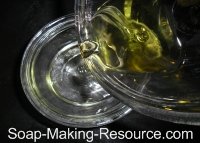
I do this so that if I make a mistake in my measurements with one of the oils, I can always use a pipette to remove some of the over-poured oil until the amount is adjusted to my desired weight. This would obviously not be possible if I was measuring out the essential oils while directly combining them with the other ingredients in my blend.
Next, we will prepare our egg yolks to be added to our shampoo bar recipe. We will be adding 3 medium egg yolks to this 5 pound batch of soap.
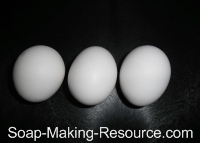
There are a few simple steps when using eggs in soap making. First, it is best to only use the yolk of the egg as the egg whites have a protein in them that may produce a sulfur-like smell in your finished product if the batch gets too hot.
So your very first step in preparing your eggs for soap making is to separate the egg yolk from the egg white. Do this by carefully transferring the yolk from one half of your shell to the other while allowing the egg whites to drop into a bowl below.
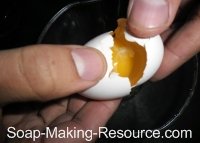
Once all the egg white is removed from the yolk, place the egg yolk into a separate bowl. Repeat this step until you have 3 prepared egg yolks with fully removed whites in your bowl. You can discard the egg whites or I suppose you can always use them for cooking if you have planned ahead a recipe in which they can be utilized.

One final step is required to prepare your eggs for soap making. You must remove the thin membrane from the yolks as this thin film will not incorporate well into the batch and will likely remain suspended in one of your bars. Yeah... Gross. So unless you want to explain to whoever is using your soap exactly why there is a chicken egg membrane floating in their bath tub, I would definitely be sure to remove this part of the egg!
Now, beat your eggs until they are an even color and texture.
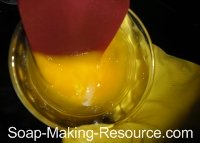
Before we add the eggs to our shampoo bar recipe batch we will need to temper them. This will be explained further down the page.
|
Sign Up Today!
*Your information is SAFE with us! |
Step 4) Now that we have finished preparing all of our additives, our soap making oils should have had plenty of time to fully melt. Take your soap pot off the burner and place a thermometer into the hot oil. At this point, your lye solution has also cooled down quite substantially.
We need to lower the temperature of our oils before using them in our shampoo bar recipe. You may also need to lower the temperature of your lye solution if it is still too warm. For this shampoo bar recipe we want both mixtures to be below 80 degrees Fahrenheit. We are soaping relatively cool because too much heat will cause your eggs to cook before they are fully integrated into your batch.
You can cool both mixtures in a sink filled with ice water as seen in the picture below:
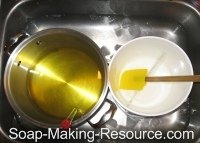
Step 5) Now that your additives are prepared for addition into your shampoo bar recipe and your lye solution and oils mixture are cooled down to below 80 degrees, we are finally ready to make soap!
Carefully take your lye solution and pour it slowly into your soap making oils. At first, stir manually using a silicone spatula or wooden spoon until an even texture and color is achieved.
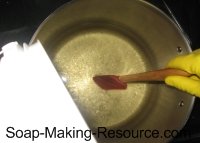
At this point, you will want to temper your eggs so that they are ready to be added to your soap once a thin trace is reached. To temper your eggs, remove a small portion of soap batter from your main pot and pour it into your bowl of eggs. Manually mix the two components together.
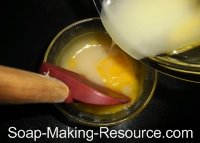
Tempering your eggs will allow them to gradually adjust to the temperature of your soap and keep them from cooking upon contact when you add them to your soap batch.
Now that your soap batch is an even color and texture, begin mixing with your stick blender until you reach a light trace.
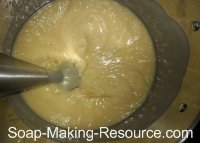
You can test for trace by dribbling a small amount of soap onto the surface of your batch. If the soap sits on top of the rest of your batch for a few moments before sinking back down, you have reached trace.
Keep in mind that you don't want your soap to get too thick just yet, so don't mix with your stick blender for too long. You still want your soap to be somewhat thin as we need some time to add our additives and don't want to risk having our soap solidify in the pot!
Now that you have reached a light trace, add your essential oil blend and stir it in manually until your soap is an even color and texture.
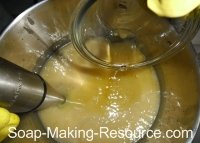
Next, add your tempered eggs.
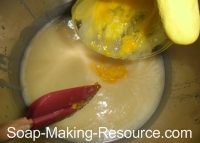
At this point you can mix everything in with your stick blender until your soap reaches a medium trace. Generally, I allow my soap to thicken up to about the consistency of a thin pudding. Keep in mind that once you add your eggs, you should mix constantly as you want them to be fully integrated into your batch. If you stop stirring, they can potentially cook before fully mixed in, causing particles of "scrambled eggs" to be suspended within your product.
Step 6) Finally, pour your finished soap into your prepared mold. In the picture below, I am using the Soap Making Resource 5 pound acrylic log soap mold.
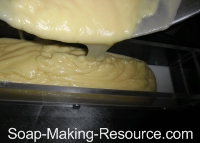
you can also use one of our 5 pound wooden soap molds. If using a wooden mold, just be sure to line your mold with butcher or freezer paper according to our mold lining instructions.
Step 7) After about 24 hours, your soap will be adequately solidified allowing you to remove it from the mold without damage. It's easy to perfectly remove your soap if using one of Soap Making Resource's acrylic log molds!
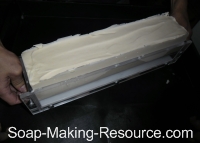
Step 8) Now cut your log of soap into bars. In the picture below, I am using Soap Making Resource's adjustable guided soap cutter.
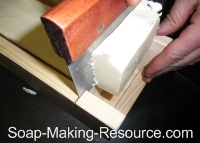
Step 9) Once all your soap bars are sliced, place them on a rack to cure.
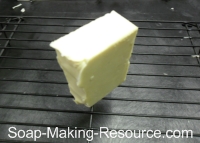
Let your newly created soap cure for about 6 - 8 weeks. This extended cure time will allow the excess water to evaporate from your product creating a harder and longer lasting bar of soap.
Step 10) Last but not least... Enjoy using your all natural shampoo soap!
I hope that you all enjoyed my shampoo bar recipe tutorial with eggs, silk and custom hair-care essential oil blend!
Don't forget to pick up the kit if you want to make this recipe at home or you can always purchase the ingredients used in this recipe in bulk at soap-making-resource.com
Return from shampoo bar recipe to the soap recipes hub page.

